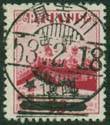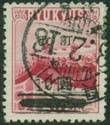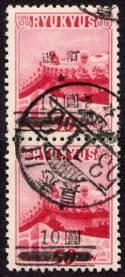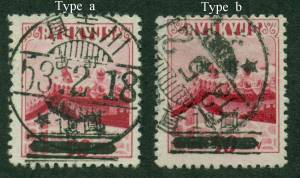George C. Baxley | |||||||||||||||||||||||||||||||||||||||||||||||||||||||||||||||||||||||||||||||||||||||||||||||||||||||||||||||||||||||||||||||||||||||||||||||||||||||||||||||||||||||||||||||||||||||||||||||||||||||||
| Scott 16 | Scott 16A | Scott 16B | Scott 16,16A,16B |
|---|---|---|---|
| Second Printing | First Printing | Third Printing | All Three Printings |
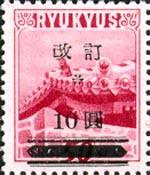 |
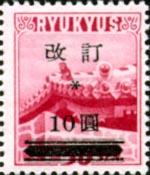 |
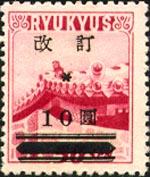 |
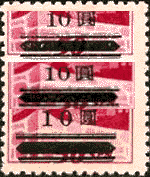 |
|
Forgeries Discovered in 1973 |
|||
Measurements - Sheet Layout - Varieties & Errors - General Comments

Narrow Spaced Bars - Narrow Spaced "10"
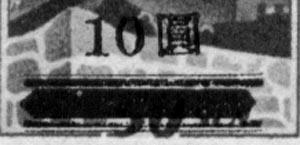

8 Point Setting - Smaller Type Font
A1 - The bottom gap in the backward five is relatively closed (Kai).
A2 - The diagonal downstroke in the adjoining character enters
the bottom gap in the backward five ( )(Kai).
A3 - The top (horizontal) stroke of the backward five has a level to slighlty downward bias.
B - The "J" type stroke is smaller and has a very small bump (almost flat)
at the end of the upper horizontal stroke (Tei).
)(Kai).
A3 - The top (horizontal) stroke of the backward five has a level to slighlty downward bias.
B - The "J" type stroke is smaller and has a very small bump (almost flat)
at the end of the upper horizontal stroke (Tei).

9 Point - Larger Type Font
A1 - The bottom gap in the backward five is relatively open (Kai).
A2 - The diagonal downstroke in the adjoining character stops short of
entering the bottom gap in the backward five ( )(Kai).
A3 - The top (horizontal) stroke of the backward five has a level to slighlty upward bias (Kai).
B - The "J" type stroke is larger and has a large bump at the end of
the upper horizontal stroke (Tei).
)(Kai).
A3 - The top (horizontal) stroke of the backward five has a level to slighlty upward bias (Kai).
B - The "J" type stroke is larger and has a large bump at the end of
the upper horizontal stroke (Tei).
Measurements of Genuine and Forged Overprints.
Genuine Scott 16, 16A & 16B and Forgeries (a~h)
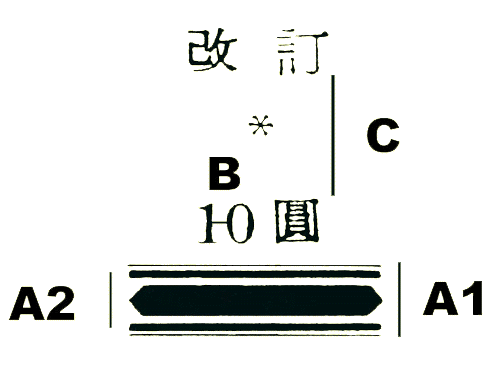
| |
|
||||
| Wide Bars | |||||
| Narrow Bars | |||||
| Wide "10" | |||||
| Wide Bars | |||||
| Narrow Bars | |||||
| Wide "10" | |||||
|
Distance Between: A1 - Outside of the Top and Bottom Thin Bars. A2 - Inside of the Inner Thick Bars. B - "1" and "0" using the Vertical Stroke of the 1. C - Bottom of the "Tei" and highest point on the Yen character. |
|||||
RPSS earliest (1952.1.17) recorded use of 16A, see here.
| 9 point | 8 point | ||||||||
Click on the Number for More Information |
|||||||||
| 1 | 2 | 3 | 4 | 5 | 6 | 7 | 8 | 9 | 10 |
| 11 | 12 | 13 | 14 | 15 | 16 | 17 | 18 | 19 | 20 |
| 21 | 22 | 23 | 24 | 25 | 26 | 27 | 28 | 29 | 30 |
| 31 | 32 | 33 | 34 | 35 | 36 | 37 | 38 | 39 | 40 |
| 41 | 42 | 43 | 44 | 45 | 46 | 47 | 48 | 49 | 50 | 51 | 52 | 53 | 54 | 55 | 56 | 57 | 58 | 59 | 60 | 61 | 62 | 63 | 64 | 65 | 66 | 67 | 68 | 69 | 70 | 71 | 72 | 73 | 74 | 75 | 76 | 77 | 78 | 79 | 80 | 81 | 82 | 83 | 84 | 85 | 86 | 87 | 88 | 89 | 90 | 91 | 92 | 93 | 94 | 95 | 96 | 97 | 98 | 99 | 100 |
Varieties Plate Specific Variations in Scott 16A (1st Printing). Position Variation 3 White spot (ca 1/3 in from right) on the large heavy bar, sometimes referred to as "worm eaten bar" - probably not a constant variety 10 Slight doubling (blurring) of Kai Tei - probably not a constant variety
17 Inverted (reversed) bars at bottom with thick bar on bottom
33 Break in vertical stroke of "Tei"
33 ?? Partial break in vertical stroke of "Tei" Bottom thin bar dropped and overall surcharge measures 4+mm vrs normal 3.5mm, 9 pt
(left stamp possibly position 33) 43,44 Top right of diagonal stroke of "Kai" missing
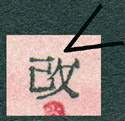
72 Wide spaced bars -top & bottom- similar to 2nd printing
73 Wrong font (small) "0" - dropped thin "0"
76 White Sky in basic stamp
82 Broken Yen character (break at upper right) minor and perhaps not constant variety 83 Lumpy "0" - right side of"0" has bump not listed in Scott or JSCA - not a contant variety
86 Wide spaced bottom bar, spaced wider than pos 95
95 Wide spaced bottom bar, not spaced as wide as pos 86
99 9 point with inscription in margin
Click here to see a block of 20 with postions: 61-5, 71-5, 81-5, 91-5 Kai Tei Variations/Combinations 9p/8p/9p Strip of three 9p/8p/9p - only one per sheet, positons 22-23-24 9p/8p (Horizontal Pair) Pair 9p on left and 8p on right - eight (8) in a sheet
8p/9p (Vertical Pair) Pair 8p on top and 9p on bottom - ten (10) in a sheet
9p/8p (Vertical Pair) Pair 9p on top and 8p on bottom - nine (9) in a sheet Inscription Block Lower right block of 6 or 10 with inscription For an excellent detailed discussion of the Ryukyu Islands 10 yen Kai Tei overprint series you can consult, From the Dragon's Den, Volume 14:2, (Whole No. 45) April, 1982. FTDD is the official publication of the Ryukyu Philatelic Specialists Society, LTD.
Quantity Printed:
16 200,000
16A 200,000
16B 40,000
440,000 Total
Gum on 16 Series Stamps. Don't expect to find 16 series stamps with nice clean shinny gum. While they certainly can be found in that condition, it is not the norm. The norm for this series is a dry flat appearing gum. In some cases the gum has browned slightly. Pencil Plate Position Annotations on the gum side of 16 series stamps. A common practice of dealers who broke up sheets of the 16 series was to make light pencil annotations of the sheet positions on the stamps. In my opinion, this adds to the value of the item rather than detracts. It ensures that you can quickly and accurately plate the stamp(s). Below is an illustration of the back of a 16 series stamp which shows the dry flat gum and dealer's pencil annotation of position.
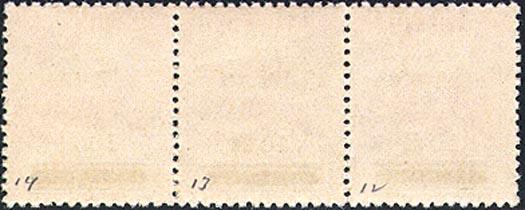
Forgeries. By the term forgery, I am referring to a stamp that was made with the intent to defraud the postal service of revenue. They are manufactured and used without paying the postal service. There are well documented forgeries of the 10 yen Kai Tei overprint. Two such forgeries are called the Gushikawa forgeries. These are discussed in From the Dragon's Den, Volume 15:2, (Whole No. 49) April, 1983. The overprints appear different than the genuine 16, 16A, 16b and they can easily be confirmed as forgeries if they have part of Gushikawa cancel (1953) as show below. Forgeries are in demand. Most collectors do not have them. Consider yourself fortunate if you have a 16 series forgery in your collection. Two types of the Gushikawa forgery have been recorded (See FTDD 15:2).
Type a. The first type has the large middle bar (pointed on both ends) with a pair of bars (thick and thin) above and below the center bar. In this respect the stamp is similar to the genuine 16s with a total of 5 bars at the bottom of the overprint. The balance of the overprint appears to have been applied separately and at times the "10" rests on the upper thin bar. The "0" in "10" is usually shorter than the "1". Dates of Use. Below are the earliest and latest date uses I have personally confirmed of both types of forged stamps.
Type a. Earliest: 52.11.26 - Latest: 53.2.18 The forgeries (to defraud the Postal Agency) are listed and valued in a footnote in the Scott Specialized Catalogue of United States Stamps & Covers at the conclusion of the listing of stamps in the 16 series. The footnote advises of the two types of forgeries. Perhaps because it is so obvious, the type b forgery is the one that I see the most.
| ||||||
Covers. Any of the 16 series stamps on cover is an excellent item. I have a steady demand for this series on cover. If you have them to sell, please contact me. |
||||||
George C. Baxley, PO Box 807, Alamogordo, NM 88311
|
|
|
|
|

